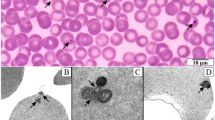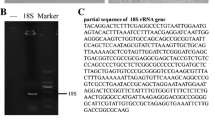Summary
Among a number of techniques for the detection of mycoplasmal contamination in African green monkey kidney (AGMK) cell lines, the assay of uridine phosphorylase activity is unsuitable because of the presence of high levels of endogenous enzymatic activity. A thymidine phosphorylase test, however, based on the chromatographic analysis of radiolabeled thymidine breakdown, turned out to be a simple and sensitive mycoplasma detection method.
We found, using the latter technique, that 0.22-μm-filtered virus inocula could still transfer mycoplasma unless treated with diethyl ether. The effect of mycoplasmal contamination on the synthesis of simian virus 40 and adenovirus in AGMK cells was negligible under the conditions used (no depletion of arginine). Incorporation of radioactive thymidine in viral macromolecules, however, was inhibited severely by the presence of mycoplasma.
Similar content being viewed by others
References
Robinson, L. B., R. H. Wichelhausen, and B. Roizman. 1956. Contamination of human cell cultures by pleuropneumonia-like organisms. Science 124: 1147–1148.
Macphereson, I. 1966. Mycoplasmas in tissue culture.. J. Cell Sci. 1: 145–168.
Stanbridge, E. 1971. Mycoplasmas and cell cultures. Bacteriol. Rev. 35: 206–227.
Hayflick, L. 1973. Screening tissue cultures for mycoplasma infections. In: P. F. Kruse Jr., and M. K. Patterson Jr. (Eds.),Tissue Culture: Methods and Applications. Academic Press, New York and London, pp. 722–728.
Harley, E. H., K. R. Rees, and A. Cohen. 1970. HeLa cell nucleic acid metabolism. The effect of mycoplasma contamination. Biochim. Biophys. Acta 213: 171–182.
Todaro, G. J., S. A. Aaronson, and E. Rands. 1971. Rapid detection of mycoplasma-infected cell cultures. Exp. Cell Res. 65: 256–257.
Fogh, J., and H. Fogh. 1964. A method for direct demonstration of pleuropneumonia-like organisms in cultured cells. Proc. Soc. Exp. Biol. Med. 117: 899–901.
Barile, M. F., R. T. Schimke, and D. B. Riggs. 1966. Presence of the arginine dihydrolase pathway in mycoplasma. J. Bacteriol. 91: 189–192.
Levine, E. M. 1972. Mycoplasma contamination of animal cell cultures: a simple, rapid detection method. Exp. Cell Res. 74: 99–109.
Levine, E. M. 1974. A simplified method for the detection of mycoplasma. In: D. M. Prescott (Ed.),Methods in Cell Biology. Vol. VIII. Academic Press, New York and London, pp. 229–248.
Reeves, W. J., Jr., A. S. Seid, and D. M. Greenberg. 1969. A new paper chromatography solvent system resolving pyrimidine-pyrimidine ribosidepyrimidine deoxyriboside mixtures. Anal. Biochem. 30: 474–477.
Perez, A. G., J. H. Kim, A. S. Gelbard, and B. Djordjevic. 1972. Altered incorporation of nucleic acid precursors by mycoplasma-infected mammalian cells in culture. Exp. Cell Res. 70: 301–310.
Barile, M. F. 1973. Mycoplasma contamination of cell cultures: mycoplasma-virus-cell culture interactions. In: J., Fogh (Ed.),Contamination in Tissue Culture Academic Press, New York and London, pp. 131–172.
Friedman, M. P., M. J. Lyons, and H. S. Ginsberg. 1970. Biochemical consequences of type 2 adenovirus and simian virus 40 double infections of African green monkey kidney cells. J. Virol. 5: 586–597.
Hirt, B., 1967. Selective extraction of polyoma DNA from infected mouse cell cultures. J. Mol. Biol. 26: 365–369.
Horoszewicz, J. S., and J. T. Grace Jr., 1964. PPLO detection in cell culture by thymidine cleavage. Bacteriol. Proc. 64: 131.
House, W., and A. Waddell. 1967. Detection of mycoplasma in cell cultures. J. Pathol. Bacteriol. 93: 125–132.
Schneider, E. L., and E. J. Stanbridge. 1975. A simple biochemical technique for the detection of mycoplasma contamination of cultured cells. In: D. M. Prescott (Ed.),Methods in Cell Biology, Vol. X. Academic Press, New York and London pp. 277–290.
Rouse, H. C., V. H. Bonifas, and R. W. Schlesinger. 1963. Dependence of adenovirus replication on arginine and inhibition of plaque formation by pleuropneumonia-like organisms. Virology 20: 357–365.
Goldblum, N., Z. Ravid, and Y. Becker. 1968. Effect of withdrawal of arginine and other amino acids on the synthesis of tumour and viral antigens of SV40 virus. J. Gen. Virol. 3: 143–146.
Author information
Authors and Affiliations
Additional information
This investigation was supported by a grant from theFonds voor Geneeskundig Wetenschappelijk Onderzoek (No. 20.298). F.V. R. is an Aspirant of the BelgianNationaal Fonds voor Wetenschappelijk Onderzoek.
Rights and permissions
About this article
Cite this article
Van Roy, F., Fiers, W. Mycoplasma in african green monkey kidney cell cultures: Biochemical detection and effects in virus-infected cells. In Vitro 13, 357–365 (1977). https://doi.org/10.1007/BF02615095
Issue Date:
DOI: https://doi.org/10.1007/BF02615095




